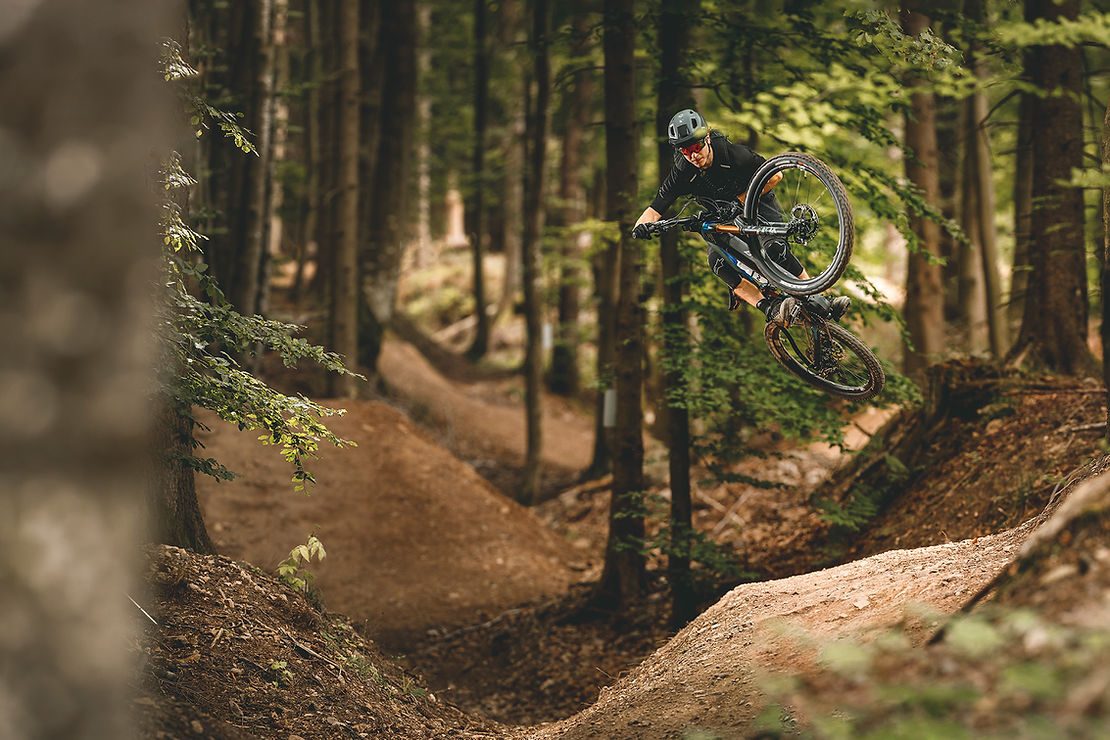Release: The all-new Canyon Spectral 29
"We’ve set out to engineer a trail bike to take on everything- no matter what the terrain, or who the rider. Using the existing, award-winning Spectral 27.5 as a starting point- we took all the things we loved, and added more. More capability and more versatility. With the all new Spectral, we believe we have created a bike which can truly sit alone in your garage- and meet the demands of whatever flavour of trail you throw at it. And if you hadn’t guessed already, it’s a 29er.
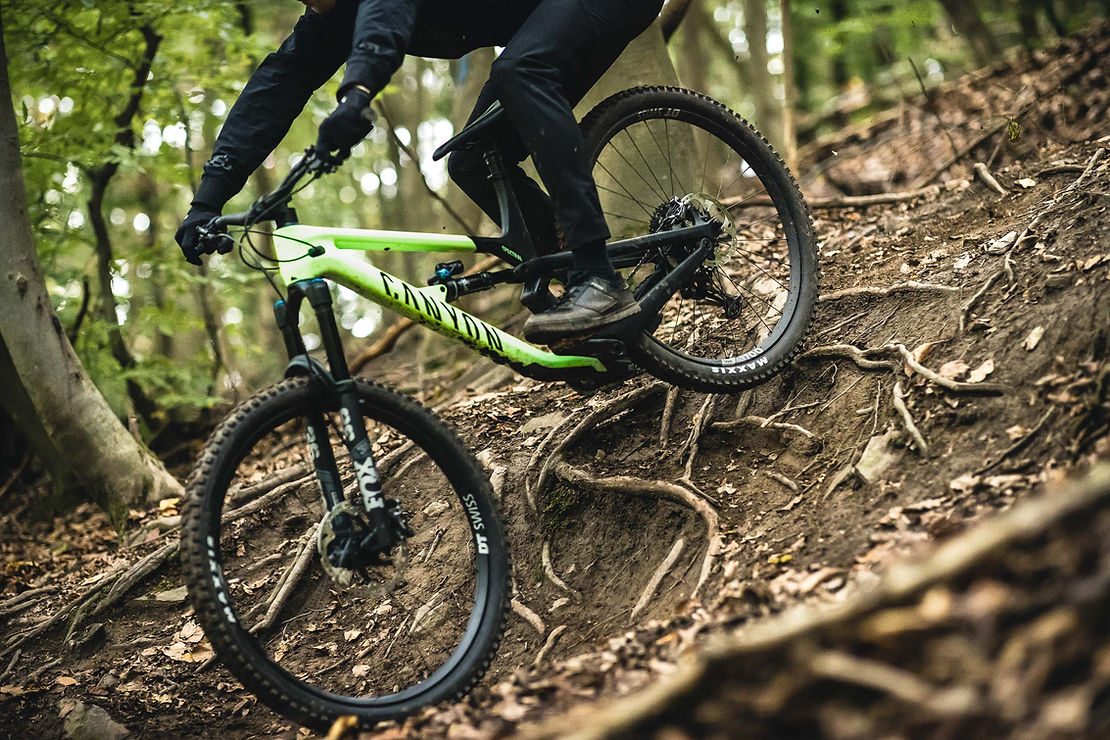
So, what’s new? Almost everything. ‘Almost’ being a key word here. The Spectral 29 CF has the same 150mm of travel and playful character on the trail as its smaller-wheeled brother. Rewarding every pump or hop and encouraging you to push harder and ride faster thanks to its Triple Phase Suspension kinematic. But here is where the similarities end. The Spectral 29 CF has an all-new carbon frame, designed from the ground up. At just 2,600 grams, it’s lighter and stiffer than before, offering the rider more direct control and increased confidence. The geometry has also been reworked; there’s more stability on the descents, as well as greater efficiency on the climbs- thanks to a slacker headtube angle, and steeper seat-tube. And to give you plenty of room to control the bike, the Reach is longer too.
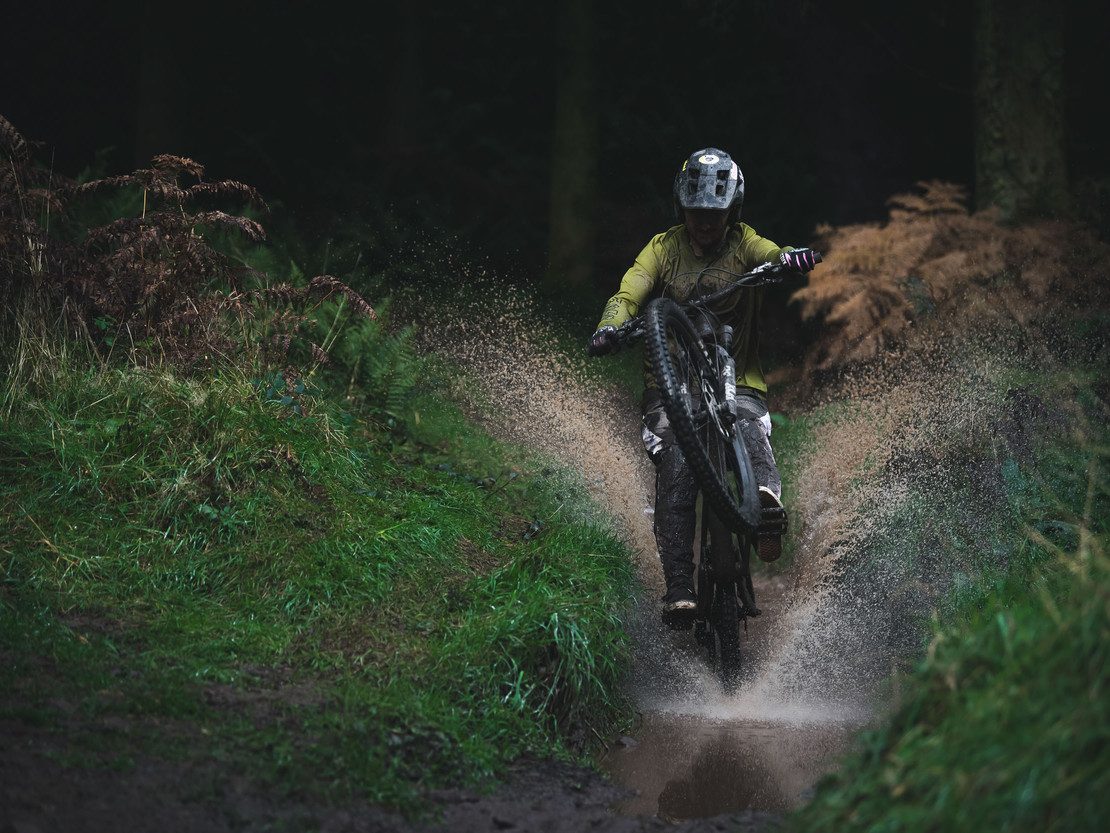
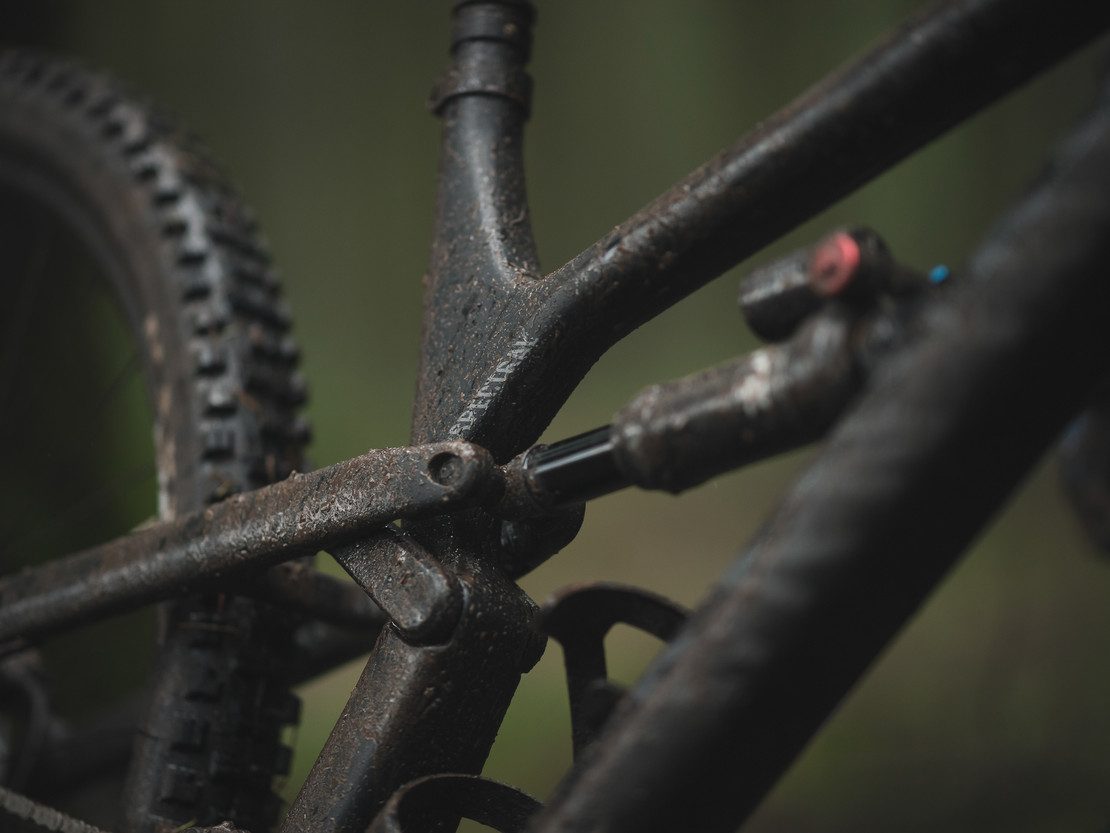



Recognising the huge variety of riders using a full-suspension trail bike, we carefully selected specification options to suit a range of ride styles. Starting at €3,299* the Spectral 29 CF 7 features the 35mm chassis of the Rockshox Pike Select RC fork, set at 150mm of travel- tuning the bike’s angles to perfectly suit all-round trail riding. Our ‘trail’ offerings are rounded off by the Spectral 29 CF 9 at €4,999* - with a 150mm travel Pike Ultimate fork, and a top-drawer SRAM X01 groupset, and carbon DT Swiss Wheelset. And for those wanting to shred – there’s the Spectral 29 CF 8 and Spectral 29 CF Ltd, featuring burlier Fox 36 forks at 160mm- slackening the geometry and upping the bike’s capability. They cost €3,999* and €5,999* respectively. Not enough options? To help dial in your setup even more- the Spectral 29 CF also features geometry adjust via a 2-position lower shock mount."
Release: Santa Cruz Bullit eBike
Santa Cruz Bullit MX could be the world’s burliest trail e-bike. Imagine the gnar-taming capabilities of the big-hitting Nomad and Megatower boosted with Shimano’s new EP8 STEPS motor and you start to see a bike that’s not only off-the-charts capability wise, but in terms of how far and wide you can go with it as well.
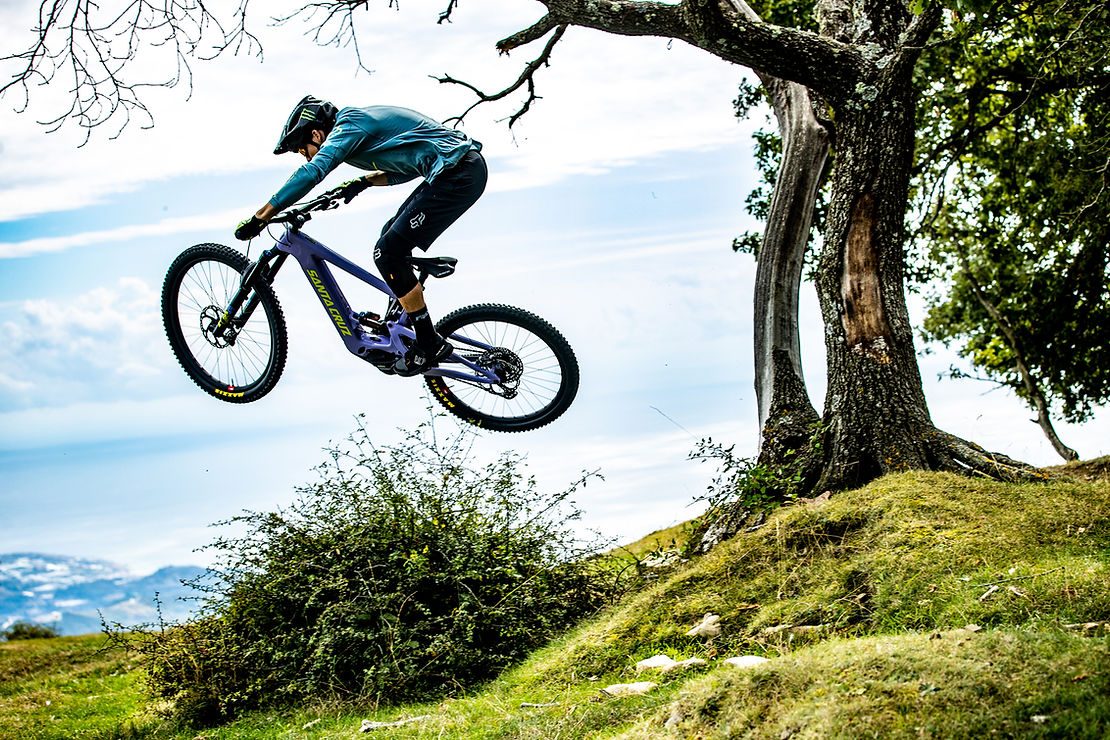
With a high-capacity 630wh battery, the more refined, more powerful—not to mention lighter and smaller—EP8 motor combined with a smasher build, Bullit turns those once-a-year epics into your regular rides, and lets you unlock new long rides you never thought possible.
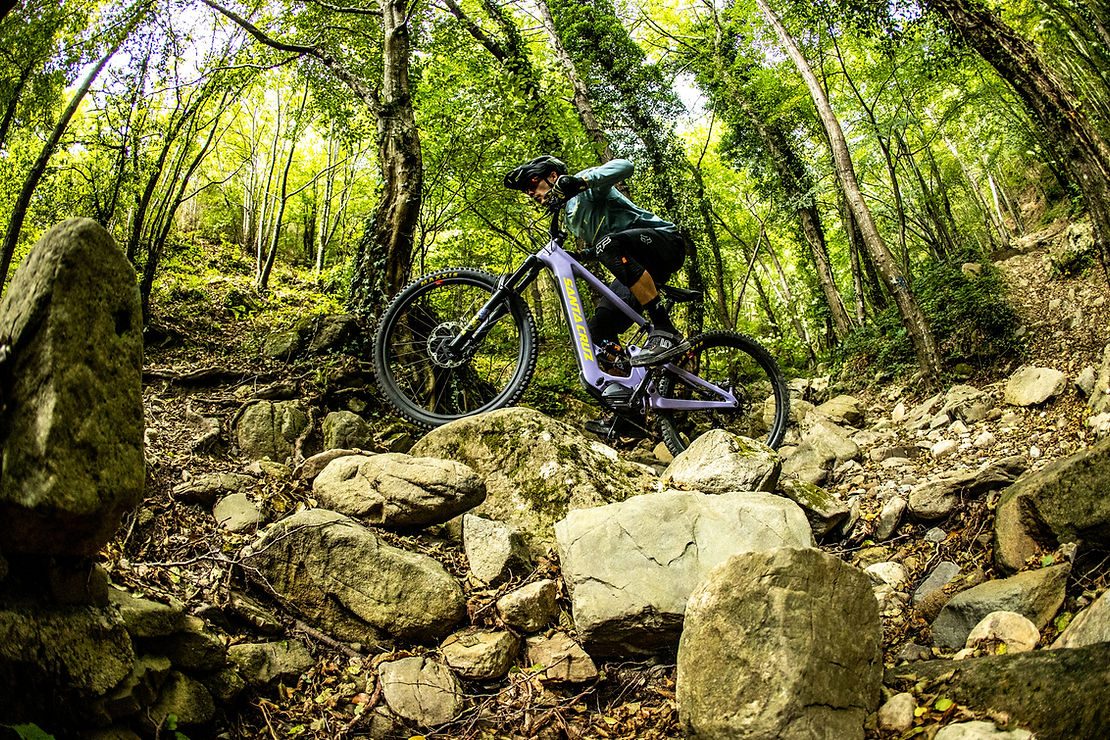
Designed for tackling the steepest and deepest of trails, Bullit’s build - 170mm-travel fork with 38mm stanchions, DoubleDown tires, coil shock options—begs for the abuse of rooty, rocky, horror fests usually reserved for the aforementioned big hitting pedal bikes. Where the Heckler puts a premium on agility and playful handling, the Bullit comes to brawl with a no-limits attitude.
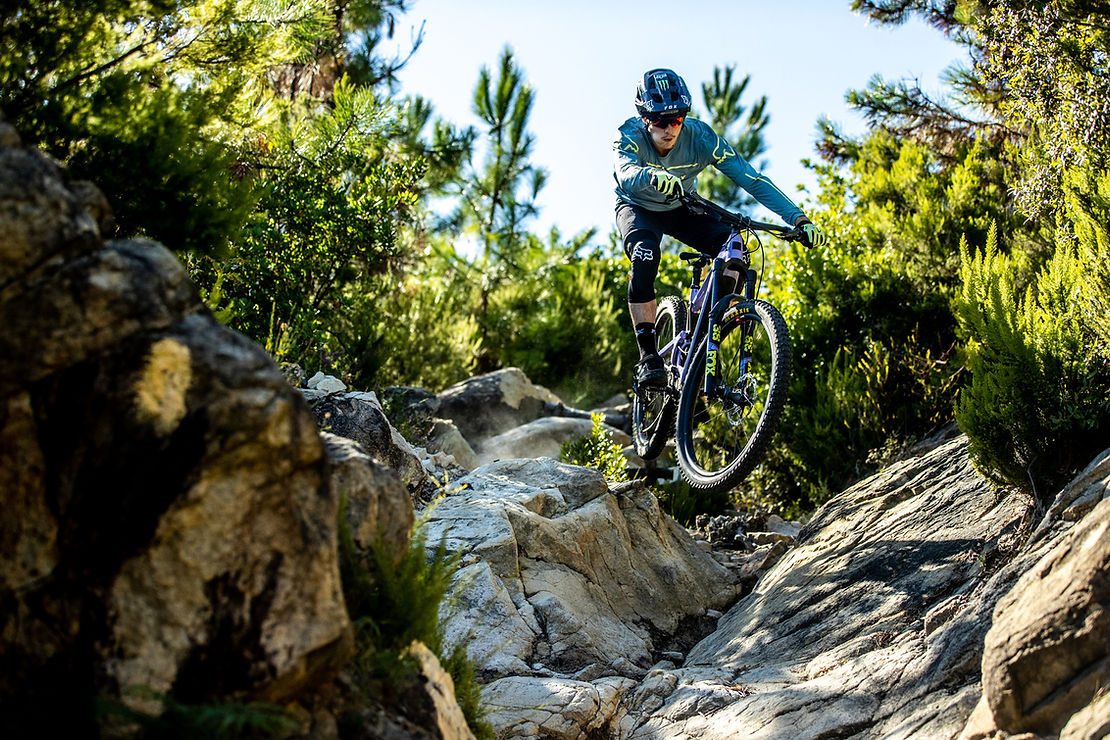
Like many of our bikes, the inspiration for this one initially came from the Syndicate - our works-level DH squad. After champion puzzler and downhill demon Loris Vergier talked us into a mixed wheel V10 DH sled, it was really just a matter of time before we brought that World Cup mindset to a broader use case. And like with Loris’ race bike, we’ve found it provides the confidence-at-speed of a 29er with the more spritely handling characteristics and manoeuvrability of a 27.5 rear end. Unlike Loris’ V10, however, this big hitting mixed bike goes uphill as well.
Release: Santa Cruz Heckler EP8 & MX
"The Heckler is about expanding your own trail map – accessing previously unreachable trails, unlocking less-used trails and doing so independently.The full carbon frame and interchangeable 504wh battery keeps the weight down (45.3lb) compared to bikes with larger batteries but it’s fast and easy to put in a fresh battery for even bigger, longer days.
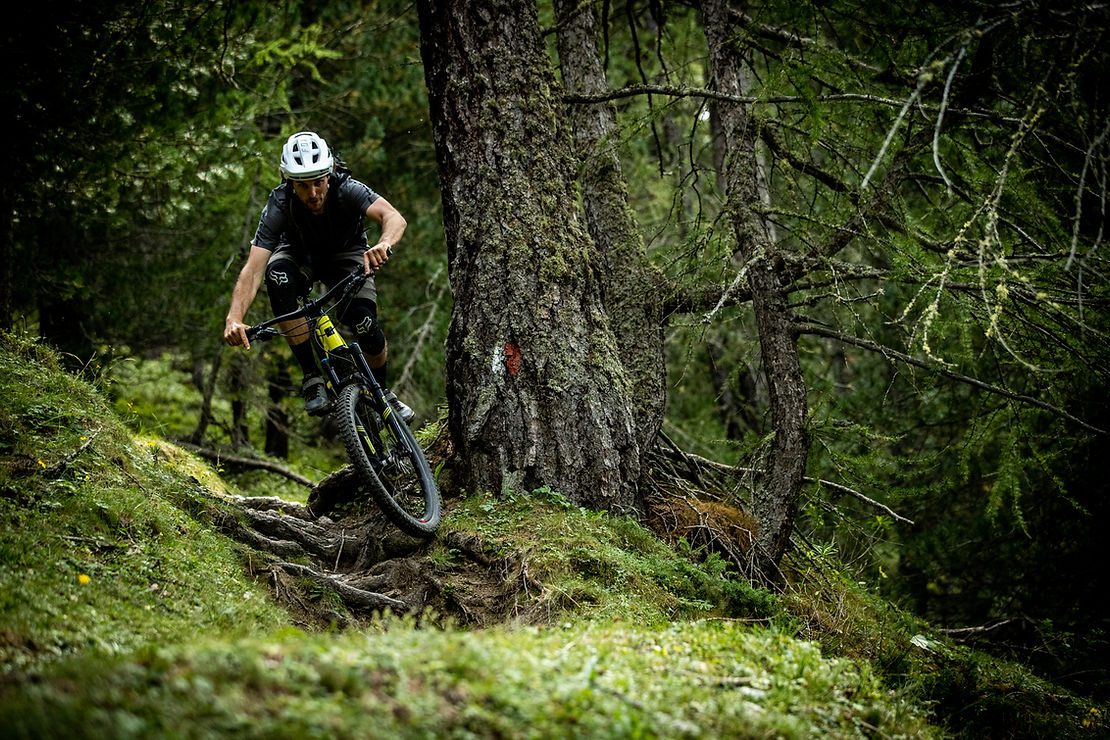
The new Shimano EP8 motor is lighter than the previous unit (310g), has more power (85Nm versus 70Nm), smaller volume (-10%) for greater ground clearance, less drag (36%), more heat resistant, and tuned to give more power in Trail mode. All this means it’s even more capable of tackling longer, tougher rides.
The 27.5-inch wheels keep the bike playful and maneuverable in order to make the most of the trail. The slack headangle (65.5-degree) and 445mm chainstay length provide a snappy and fun feel while still providing traction for when the trail gets steep and technical, both up and down.
Like all Santa Cruz bikes, the Heckler pedals well regardless of watts involved. The 160mm-travel fork is paired with 150mm-travel at the rear to provide a wide range of capabilities. We tweaked the VPP kinematics to have slightly lower anti-squat than other bikes. This adds a touch more support and traction over rough stuff when pedalling seated - a major advantage of having the pedal-assist on your side.
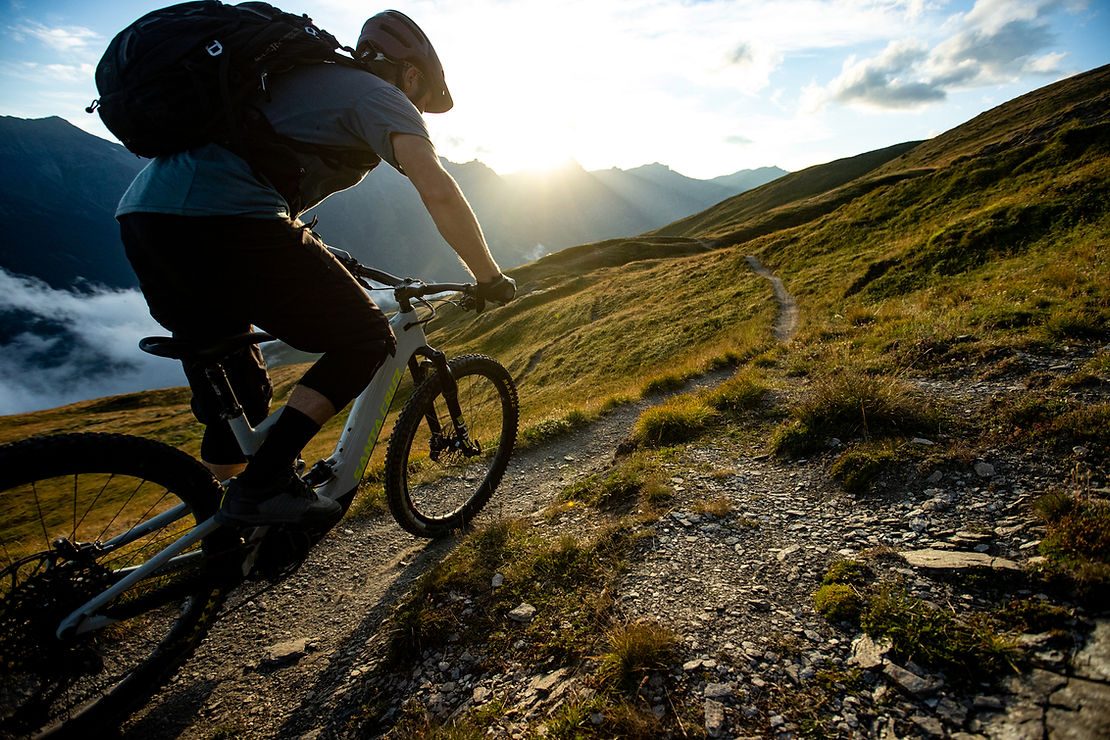
And like every Santa Cruz bike, the Heckler is built for the rigors of true mountain biking. Shimano electronics were chosen for their refinement and reliability, while quality pivot hardware, easily replaceable radial bearings and no-nonsense internal cabling were considered with a mechanics sanity in mind!
The Heckler’s boundaries aren’t defined by distance, laps, or time. The boundaries in our head that say, “Don’t bother”, “Turn back”, “Impossible.” Smashing these boundaries is what got us hooked on riding in the first place. Heckler’s not about taking things easy, it’s about making things possible.
Heckler MX
Our bikes have always been about amplifying fun. So our goal for the Heckler MX was to make something light and agile that can help you on-site blind terrain. A mixed-wheel bike gives the confidence of a 29-inch wheel up front for traction and roll-over when you’re caught off guard by technical features. The 27.5 rear wheel allowed us to keep the moderate chainstay length of the Heckler (445mm), which provides a snappy and easy-to-handle bike on tight, demanding trails. We did this without compromising on the standard Heckler’s geometry, so the bike’s character is still very light and accurate.
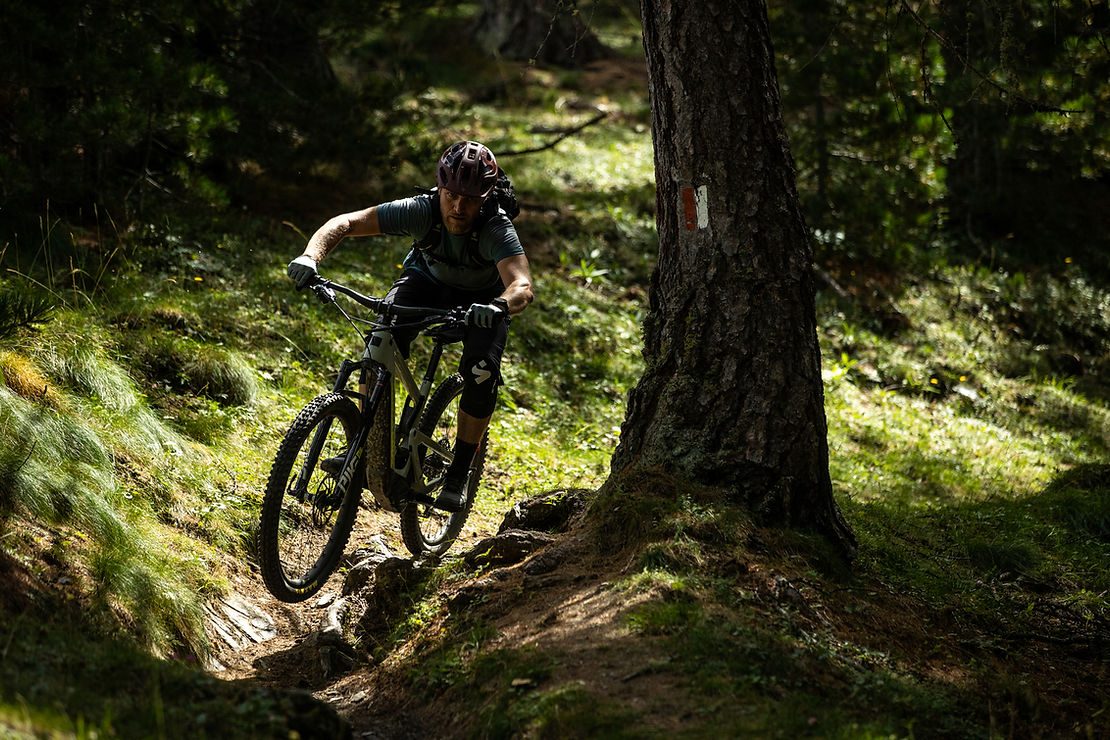
The Heckler is about expanding your own trail map - accessing previously unreachable trails, unlocking less-used trails and doing so independently. Whether tackling rides that are guarded by monstrous climbs, cramming more into less time, it’s about rarer rides becoming the norm for you. The interchangeable 500wh battery keeps the weight down compared to bikes with larger batteries but it’s fast and easy to put in a fresh battery for even bigger, longer days.
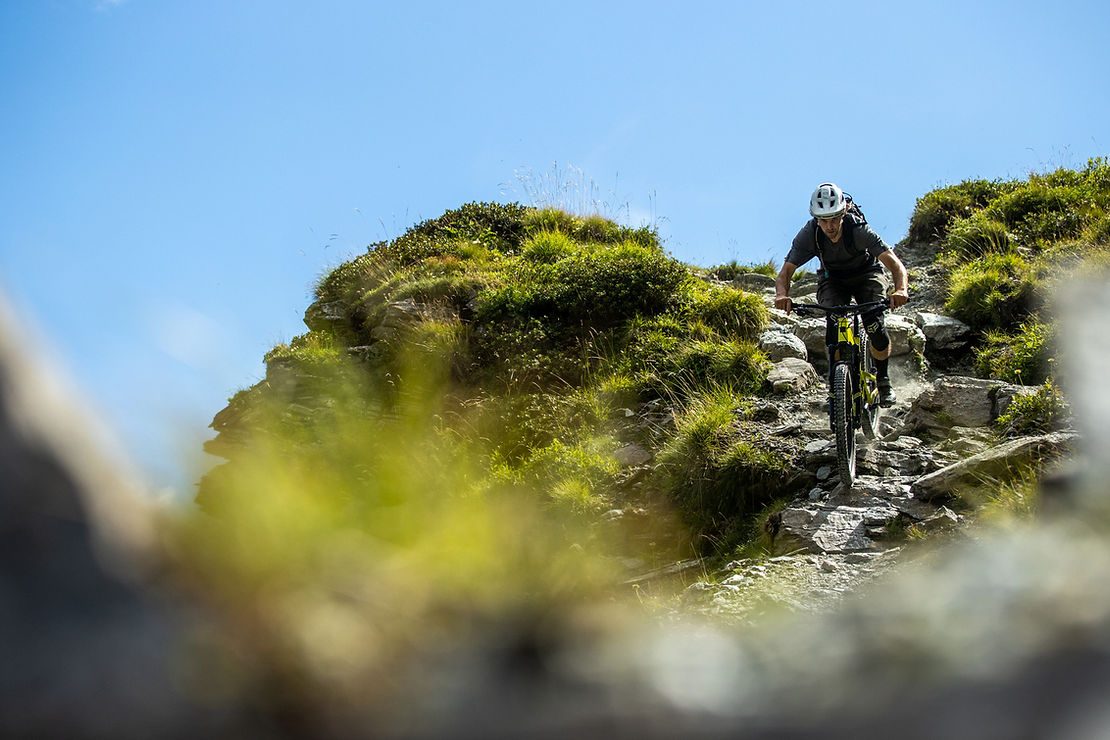
The new Shimano EP8 motor is lighter than E8000 drive unit (380g), has more power (85Nm versus 70Nm), smaller volume (-10%) for greater ground clearance, less drag (50%), more heat resistant, and tuned to give more power in Trail mode. All this means it’s even more capable of tackling longer, tougher rides. We use the full Shimano STEPS battery and motor system again because it means assured reliability and global aftermarket service."
Release: Specialized 2FO Roost Shoes
"At Specialized we’ve spent a lot of time in the saddle and on our feet considering ways to make better cycling shoes. The key is listening to what our own bodies and team riders want in order to develop equipment that meets everyone’s needs. Trail riders want function, comfort, and style. With the Roost, we’re giving riders a shoe that outperforms the competition on the trail, while keeping riders looking good and feeling fresh on and off the bike. Roost for every occasion.
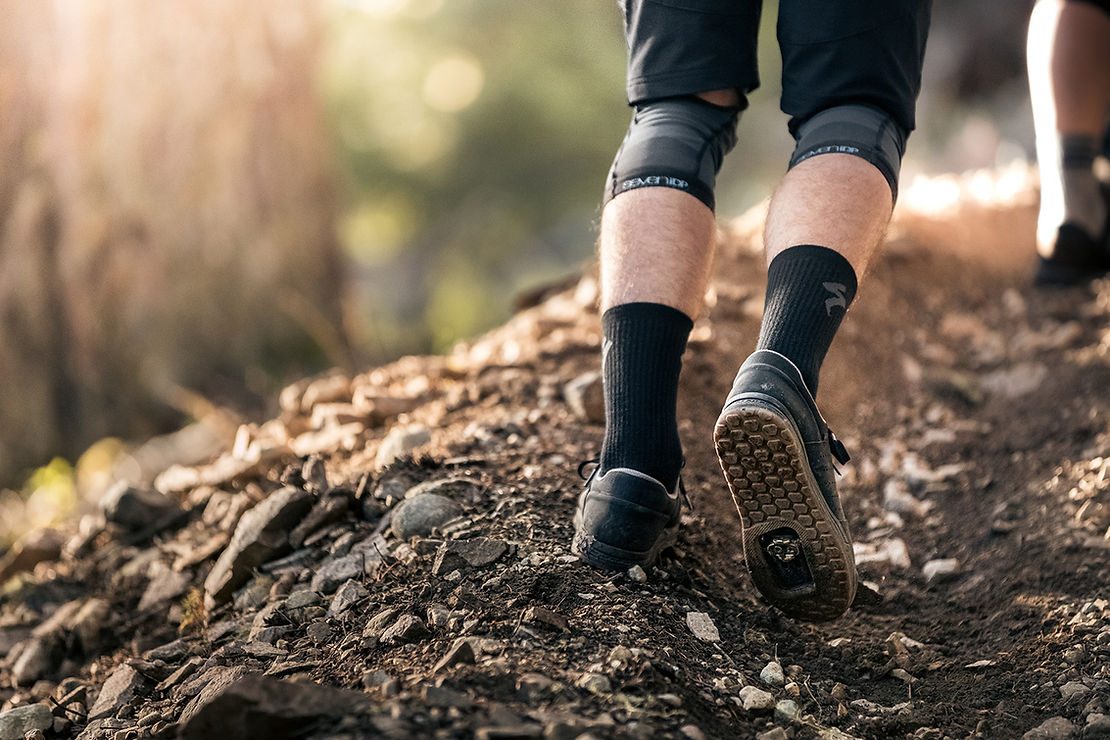
We think of rubber as being bouncy, but bouncy is not what you want in a flat pedal shoe. You want a rubber sole that grips the pins of the pedals without feeling squishy, which gives you confidence that your feet are going to stay put on the pedals. That leaves less to worry about and more to shred about.
The 2FO Roost features our newly developed 3rd generation SlipNot rubber sole designed to stick to and hug pedal pins. Giving riders a sticky, bounceless feel while ripping through rough braking bumps and across trail chunder...chunder? At least that’s what our test riders keep saying.
The clipless version of the 2FO Roost keeps the next generation SlipNot outsole and adds a roomy cleat pocket making it easier to engage your pedals in even the roughest trail situations.
Both models are stiff enough to give you the support needed for a long day out on the bike while remaining flexible enough to make those unexpected hike-a-bike sections or an afternoon shooting the breeze at the local shop completely comfortable. Leave that second set of shoes at home. With the 2FO Roost, you’ll be perfectly dressed for any occasion.
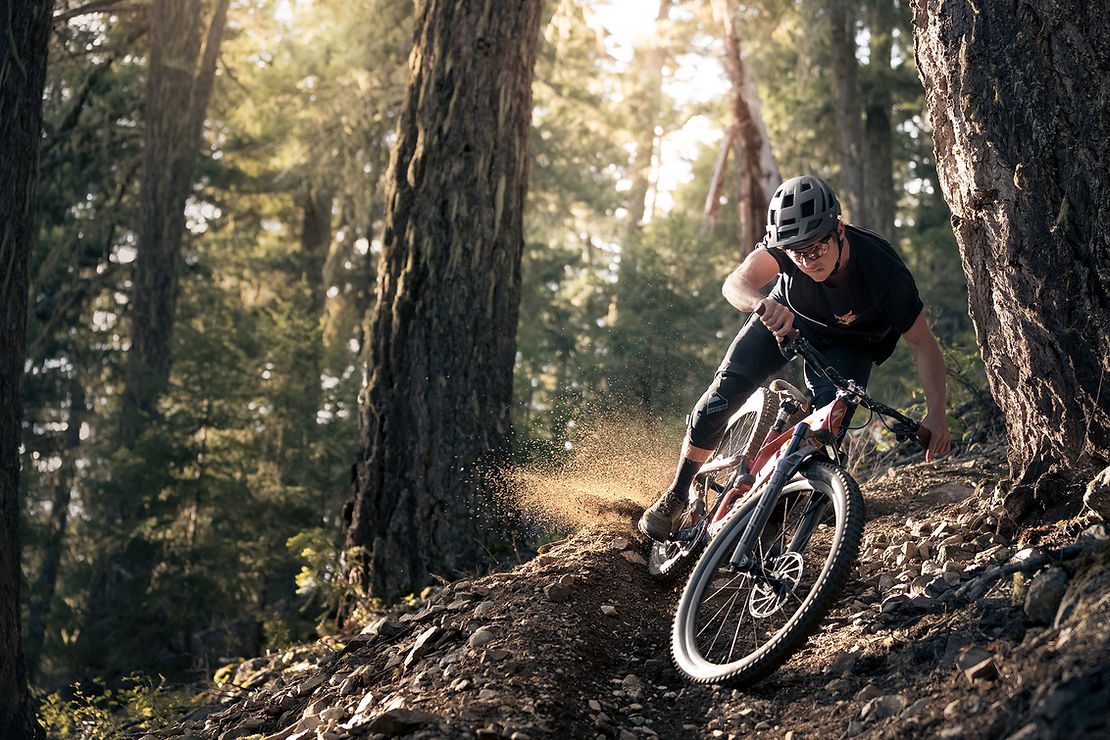
We wanted to keep the Roost as light as possible, so we did away with the traditional foam padding in the upper and replaced it with Xpel™ Airmesh. A lighter, more breathable material, Xpel™ Airmesh retains all the impact reduction properties of traditional padding but with reduced weight a significant increase in drying speed. Because no one wants to ride in wet shoes. And that’s a fact.
How did we take all this science and put it into a shoe that looks this good? A shoe that looks at home in your favorite happy hour spot and while sending your dream line? Designer magic.
But I think we can pull some things out of the hat:
Suede hits and caps are added to the upper in high wear areas for increased longevity and decreased scuff abrasion.
We designed a clean, low-rise silhouette to create a shoe that looks as good on the bike as it does at the brew pub.
It's all mixed together with some sensibly subtle colors and minimal branding, so no matter where the trail end’s you can stick to it and Roost."
WIN! With NZ Mountain Biker & earSHOTS

It's not quite summer yet, but we've partnered with our friends at earSHOTS to give you the chance to win some rad prizes over the next few months! From 4th November 2020, you've got the next two-weeks to make an edit of you out shredding your local trails. Upload it to your Instagram, tag us and earSHOTS, and use the hashtag #NZMSummerShredit to go in the draw to win a prize with a retail value of over $200!
How to Enter:
1 - Create a 20-30 second long video of you shredding your local trails. Must be shot and edited on a phone or similar mobile device - no cameras! Find a list of mobile video editing apps here.
2 - Upload your video to your Instagram feed and tag @nzmountainbikermagazine, @ride_earshots and #NZMSummerShredit to enter. Make sure your account isn't private for the duration of the competition, otherwise we won't be able to see your entry!
3 - On the 18th November, we'll select our three favourite videos, and then it will be up to you to vote and decide our winner! Get your friends, family and anyone else you can think of to vote for your video!
Charge up your phone, rope in a buddy, and head out to your local trails to get filming!
Terms & Conditions
The competition is only open to people living in New Zealand. Entrants will be disqualified if found to be using cameras, computers etc to create their videos. One entry per person. NZ Mountain Biker Magazine and/or earSHOTS may share your videos. By entering the competition, you grant permission for this to happen.
News: The all-new Stumpjumper
Short-travel trail bikes have long cornered the market on lightweight and snappy climbing, but also often fall short when it comes to suspension performance and big terrain capability. The new Stumpjumper tears up that old script — we’ve never made an all-round trail bike this light, efficient, AND capable. The new Stumpy brings a telepathic, magic carpet quality to your ride. It’s planted and weightless at the same time. Stable, yet nimble.
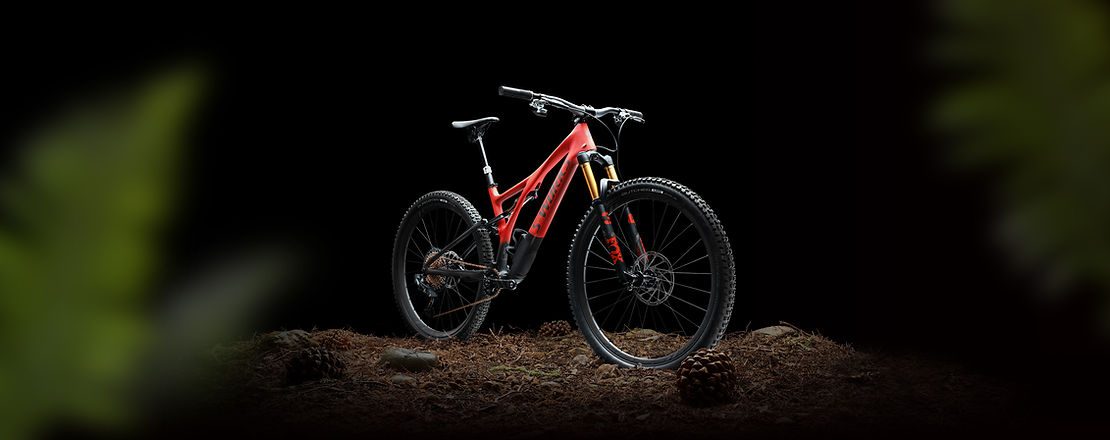
To make the Stumpy the ultimate singletrack flow finder, we combined the lightweight, efficient DNA from our Epic EVO with the benchmark handling and capability of the Stumpjumper EVO. The result is a well-balanced performer that climbs and accelerates like it has a motor, descends with conviction, and flat out tears through every conceivable trail condition.
Enjoy.
THE BACKBONE OF THE RIDE
The frame is the backbone of the bike. It’s the origin of control and efficiency and is the centerpiece of any serious weight saving effort. Ready to build with all the fixin’s*, an S-4 Stumpjumper chassis is 2,240 grams; that’s damn light! Over 100 grams lighter than the previous Stumpjumper chassis.
To get to this weight — while improving handling characteristics, pedalling efficiency, and toughness — required the development team to pull out all the stops. The process started with frame shape, proceeded to composite selection, and finished with hundreds of iterations to optimize the layup.
*Including paint, shock, all assembly hardware, link, carbon extension, molded downtube and chainstay protectors, axle, and seat clamp.
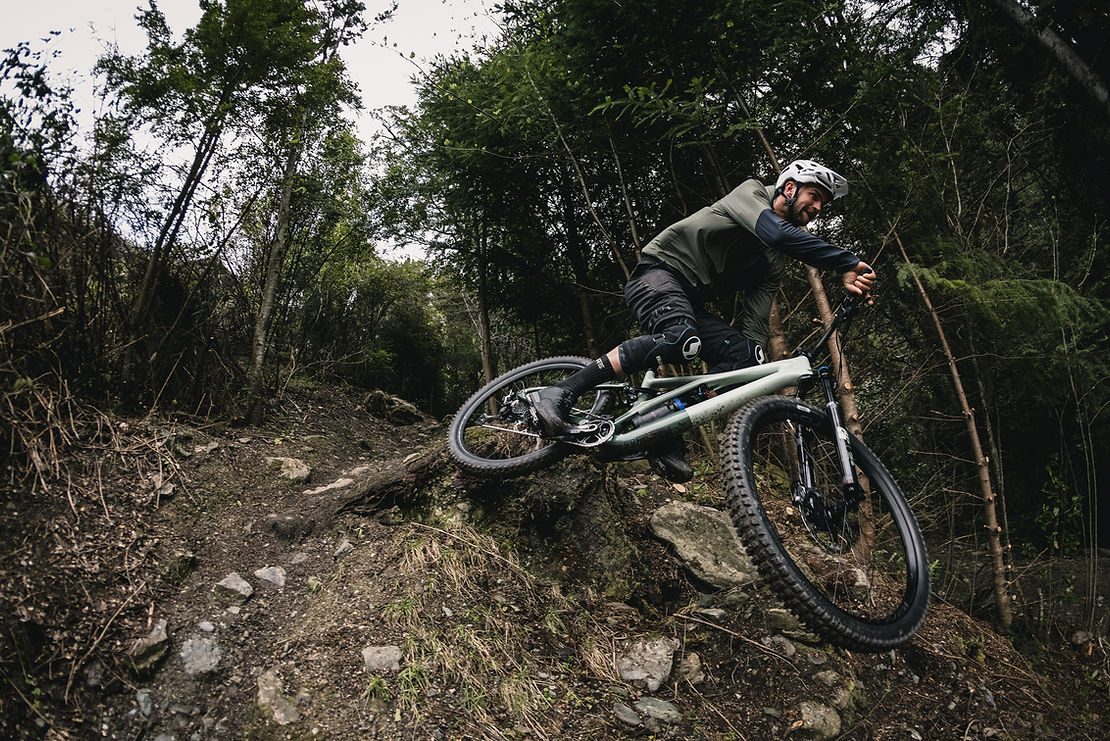
HEY LAZY CARBON, BEAT IT!
The shape of a composite frame determines the vast majority of that frame’s weight, stiffness, and durability. After crunching countless Finite Element Analysis calculations, our engineers optimized the dimensions and radii of the Stumpy’s frame tubes and their intersections, eliminating “lazy” material that would otherwise hide in unoptimized corners. This ensures that every fibre is delivering the most strength and stiffness it can.
Small adjustments in shape make big differences in how the material performs. A great example of this is the shock mount at the top tube. By keeping the top tube “intact” (rather than piercing and bending it to shroud the shock, like the previous Stumpjumper), it’s more structurally sound and therefore more effective at bearing a load. The flat sections of the shock mount likewise carries those loads more effectively than the curved shock mounts of the previous Stumpy. Together, this top tube/shock mount section is lighter AND stiffer than its predecessor, without sacrificing durability.
Another example of how shape optimizes material use is the Sidearm design. The asymmetric Sidearm strut supports the shock link pivot, boosting stiffness by connecting rear end with front for a direct and integrated feel. The Sidearm also prevents torsional loads from entering the top tube, which helps the bike track and handle with precision.
SWAT
Shit happens out on the trail. Flats, unplanned dismounts, rainstorms. Just ask Murphy, he wrote the law. Luckily the Stumpjumper’s SWAT compartment will faithfully carry all the stuff you need to get out of most trailside tight spots. And even with that high volume cavity in the downtube, our engineers figured out how to distribute all the loads around the opening. The Stumpy still delivers the stiffness required for telepathic handling on the trail, while also providing heavy-duty strength at an unprecedented light weight.
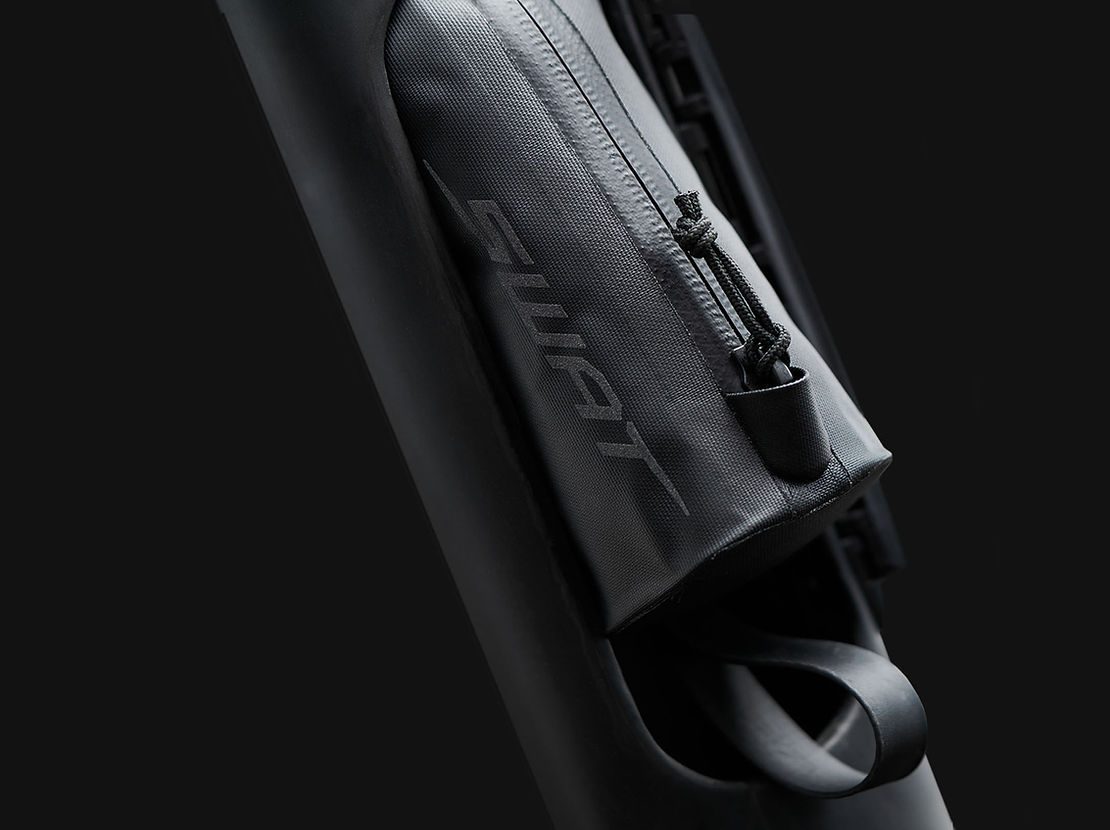
THE MISSING LINK
The pivotless seatstay/chainstay of the Stumpjumper leverages everything we’ve learned about building lightweight, full suspension trail bikes (something we’ve been doing since ‘93). A closer look at the rear dropout area revealed that there was no mechanical pivot. By applying our expertise in composites, we were able to ditch 55-grams of hardware, enhance lateral chassis stiffness, reduce maintenance, and precisely match suspension kinematics and chassis stiffness. In short, it’s the lightest, most efficient, control enhancing suspension solution for a mid-travel trail bike we’ve ever made. The elegance of this solution is fully realized and appreciated on the trail.
FLEXSTAY
Through precise shaping of the seatstays and chainstays, along with utilization of appropriate composites, we created a flex zone along the seatstay, above the brake mount, that serves up 130mm of travel without any rear end pivot hardware or redundant material required for bonding pivot parts in the carbon.
GOODBYE PIVOT, HELLO EFFICIENCY
The one-piece design improves torsional and lateral stiffness, which in turn enhances responsiveness and pedalling efficiency. These lateral and torsional stiffness gains are achieved by eliminating the flex intrinsic in mechanical pivots.
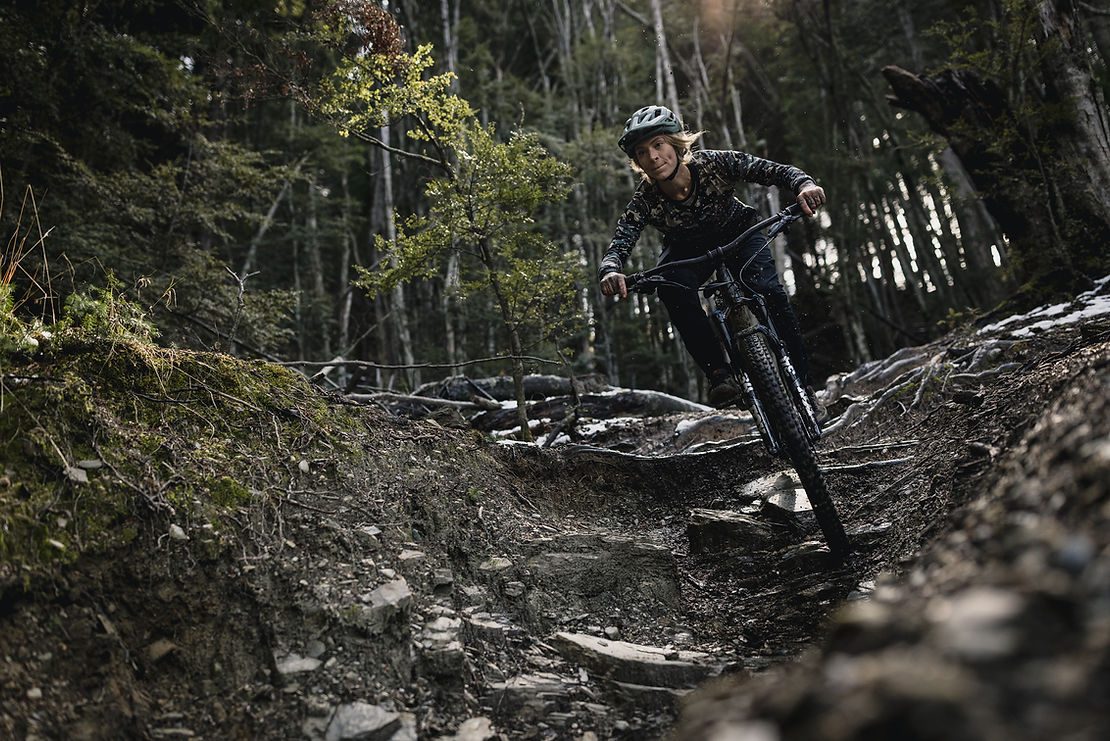
SUSPENSION
RxTUNE
Our trail obsessed team of engineers stay awake at night thinking of how to make suspension work better. For the Stumpjumper, they tailored every aspect that contributes to final suspension characteristics — kinematics, leverage curves, damping, and spring rates — to work together in harmony to deliver a highly controlled, responsive, and precise ride that handles bump forces like a bike with far more travel.
LEVERAGE RATE
The Stumpjumper has a very progressive leverage rate with a steep slope. This helps achieve a lively, snappy ride with generous utilization of travel and a good platform to pedal against through the mid-stroke, as well as great bottoming resistance at the end of the stroke. These are exactly the characteristics you want for a mid-travel trail bike designed to see full-size trail duty.
The combination of the progressive leverage ratio and mildly progressive spring rate results in precisely the ride we dreamed of for our mid-travel trail ripper. What you feel on the trail is a lively, snappy ride for the first two-thirds of travel, then — thanks to the increasing spring rate — excellent bump force management and resistance to bottoming in big events.
To ensure sufficient rebound with fast, deep hits, the progressive rebound damping catches big impacts. But, because rebound damping is lighter through the mid-stroke, it comes back quick so it’s ready to handle the next impact.

CAPABILITY AND STABILITY
The new Stumpjumper geometry contributes to a level of control and efficiency never before found from a mid-travel trail bike. How? The generous cockpit gives you the room you need — centering you on the bike and improving traction and corner control. The low bottom bracket, slack headtube angle and reduced fork offset keep things stable in the rough. A steep seat tube optimizes power output and puts your weight over the front while climbing. And short chainstays keep things flickable and nimble.
POWER TO THE PEOPLE
Creating the ultimate trail bike out of costly materials and utilizing processes typically reserved for space exploration was pretty hard. Bringing that unprecedented performance to as many riders as possible was even tougher. But we did exactly that with our new alloy Stumpjumpers, delivering the same great geo, Rx-Tuned suspension, ride quality, and S-sizing as their carbon siblings, but at much more attainable price points.
News: The all-new Stumpjumper Evo
We’re lucky to be riding during the Golden Age of mountain biking. We have access to more trails than ever, built with more diversity than ever, riders are progressing and nailing what was previously impossible, and now the new Stumpjumper EVO is evolved to meet the demands of modern riders. Delivering unprecedented control, capability and adjustability, along with unexpected climbability, it tames any terrain from chundery jank to progressive high speed flow and modern big hits. It’s your seat in the eye of the hurricane. And that’s good, ‘cause when shit starts flying on the trail, you’ll be zen in the middle of the mayhem.
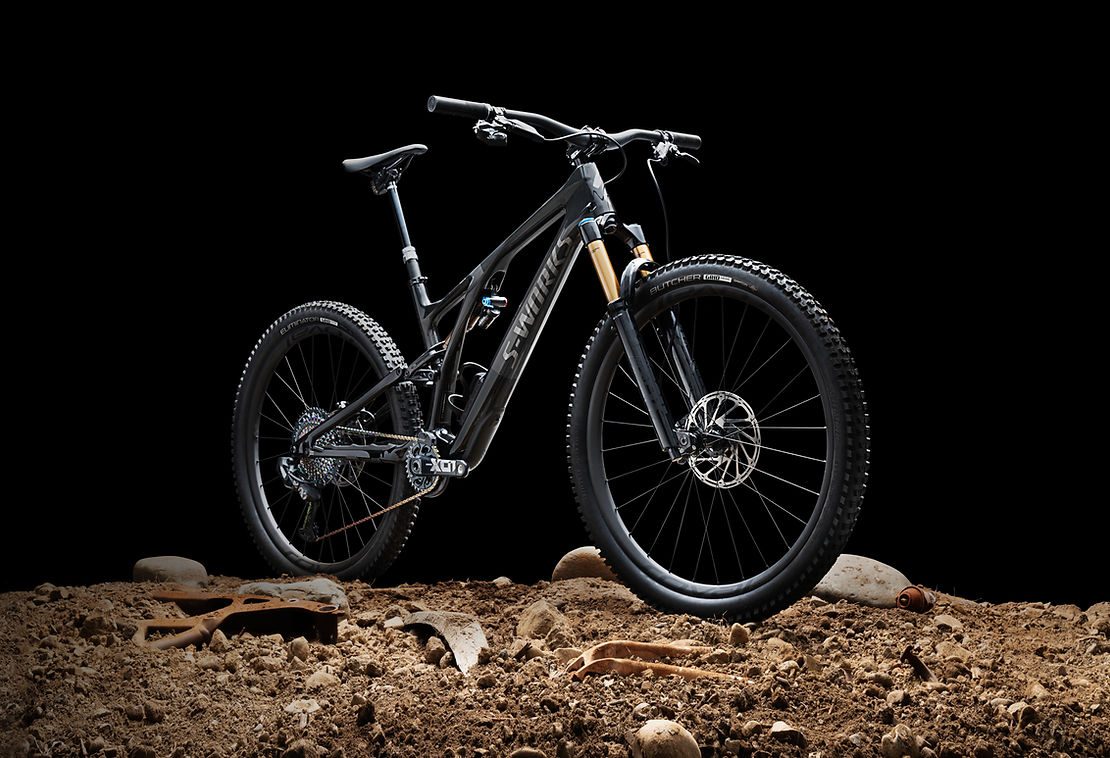
Available in six style-specific sizes, the Stumpjumper EVO sets the benchmark for progressive trail geometry, delivering DH capability never before found from a 150mm bike alongside lively climbing manners. How? The generous cockpit gives you the room you need; centering you on the bike, optimizing traction and corner control. The low bottom bracket, slack headtube angle and reduced fork offset keep things stable in the rough, while giving you the freedom to destroy the turns, float through them, or nail the inside lines. A steeper seat tube optimizes power output and puts your weight over the front while climbing. And short chainstays keep things flickable and nimble.
Mullets are a thing these days. Not the hairstyle, though. Those are best still treated with wary respect and plenty of distance. No. We are talking about a 27.5” rear wheel and a 29” front. The big hoop up front provides traction and stability everywhere, while opting to run a smaller rear wheel can liven up responsiveness and also give more physical riders a skosh more room to get rad without hooking their shorts on the rear wheel. We utilize a different, aftermarket shock link to achieve Mulletdom with the EVO, in order to retain the handling, geometry and suspension characteristics that enable the rest of the package to shred so assertively.
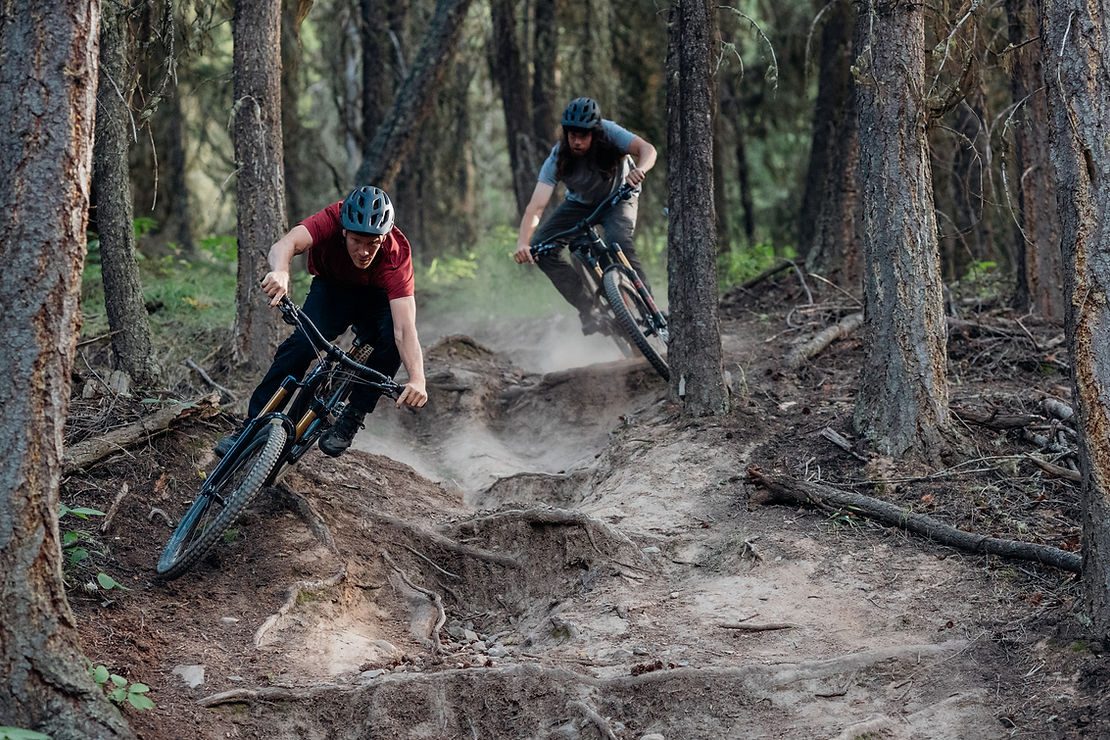
The EVO’s 160mm front travel and 150mm rear feels bottomless on big drops, supple on small bumps, devours square-edged hits, yet still pedals responsively and climbs like a lightweight. The key ingredient here is Rx Tune – your prescription for fast. Riders all, our team of engineers and technicians toiled to develop every aspect of the EVO’s suspension into an optimally performing singularity. Chassis design, telemetry, wheel rates, spring curves, custom shimstacks, oil viscosity; front and rear suspension obsessed over, prototyped and tuned to deliver optimized and balanced performance, allowing the bike to disappear beneath you, leaving you confidently in control.
The SWAT door on the Stumpjumper EVO is a masterpiece of carbon fiber construction and spatial optimization. A simple pull and twist of the water bottle cage opens into a cavernous downtube storage compartment. There’s 15% more room than before; enough room to store 22oz of life giving water in an included, specifically designed bladder. Or some tubes and a rain jacket. Or folded up slices of pizza. Or multiple bananas (careful with that last one). Because we can tailor the layup of our carbon fiber, putting material where it is needed most, we can also design in this easy access storage compartment with zero compromise of the chassis strength or stiffness.
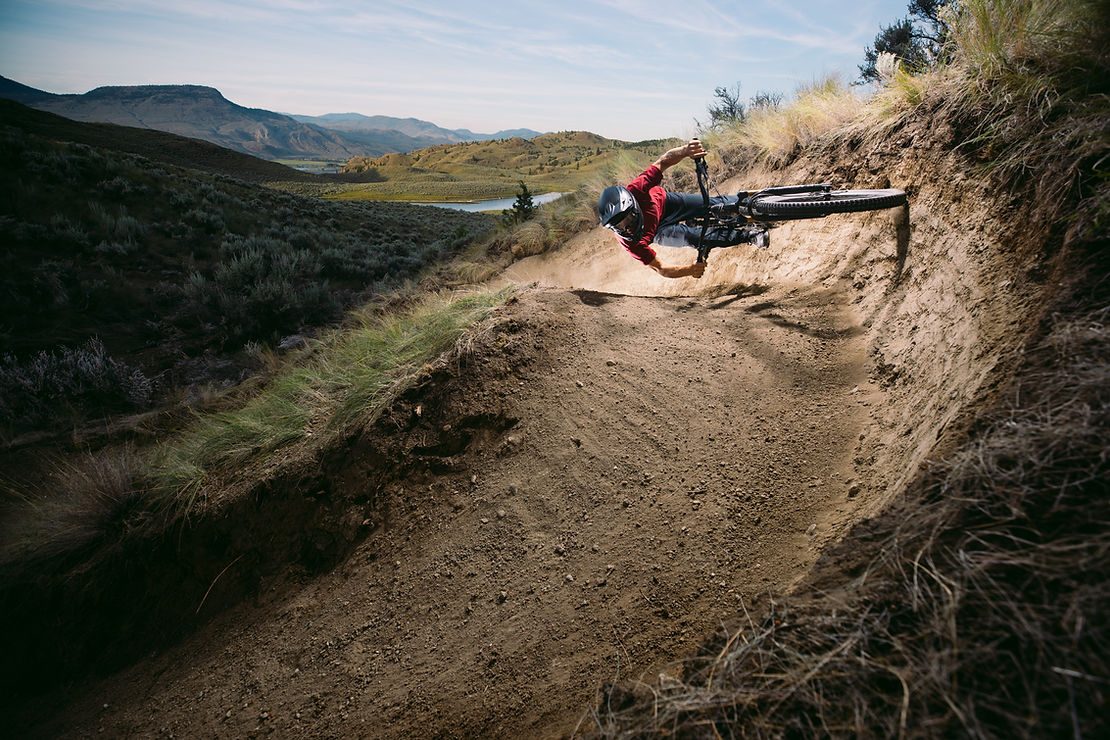
There’s a generous amount of anti-squat early in the EVO’s travel. When it comes to climbing responsiveness and pedalling snap, anti-squat is your friend. It helps you put the power to the ground without unwanted pedal-induced bob, and it transforms wattage into forward and upward momentum. As the suspension moves through its travel, the anti-squat characteristics drop below zero, and the suspension focuses on sucking up everything from chunder to dead sailoring blind hucks-to-flat.
Tech: Like a Coiled Spring
“Enduro-bro”. “Do you even enduro?” “Nice fanny pack”. Ever notice how just as soon as something is ‘fashionable’ it’s somehow even more fashionable to mock the thing (or, more likely, your riding buddy for adopting the latest trend)? That doesn’t remove the thing’s original attraction or advantage though. Take coil shocks. We’ve seen a number of top enduro racers over the last year or two running coil shocks, which has seen them adopted by everyday trail riders who realise that that it’s not just elite riders that benefits from coil shocks. So, before poking fun at your mate who now has a big orange spring in the middle of their frame, if you haven’t already, let’s consider if there is something behind the coil shock hype that might be relevant to a bike’s performance. Warning: this is going to get technical so if you don’t geek out on bike-performance, the following is probably going to be worse than watching paint dry…
Back in The Day
Before I start, it’s worth a bit of an anecdote about how my appreciation for coil shocks happened by accident. My first coil shock came with my 2005 Turner 5 Spot, which I bought used in 2007. The shock came with the frame and before I even rode it I concluded that ‘coils are for DH bikes’, and it would be ‘soft’ and therefore pedal poorly, especially uphill. So I bought a Fox RP3 (tuned by Push) to replace the coil before I even rode the bike. Guess what? Once I’d ridden both I found that the coil shock outperformed the Pushed Fox RP3 in every way. Because I’m a bike-nerd from way back, I even went to the extent of attaching my helmet-cam to the downtube and filmed the two shocks on the same piece of track. It confirmed what I felt riding the bike: the coil was way more active over small bumps, it used its full travel more effectively, yet it also remained more composed and wallowed less into its travel when climbing steeply. And there were fewer seals to blow up. On that bike I also had one of the original coil sprung RockShox Pikes and I still consider that to be the best piece of suspension I’ve ever owned in terms of its performance and reliability for the time. That was more than ten years ago, and I’ve been a fan of coil shocks ever since (but I’m usually riding test bikes now so I probably ride air shocks more).
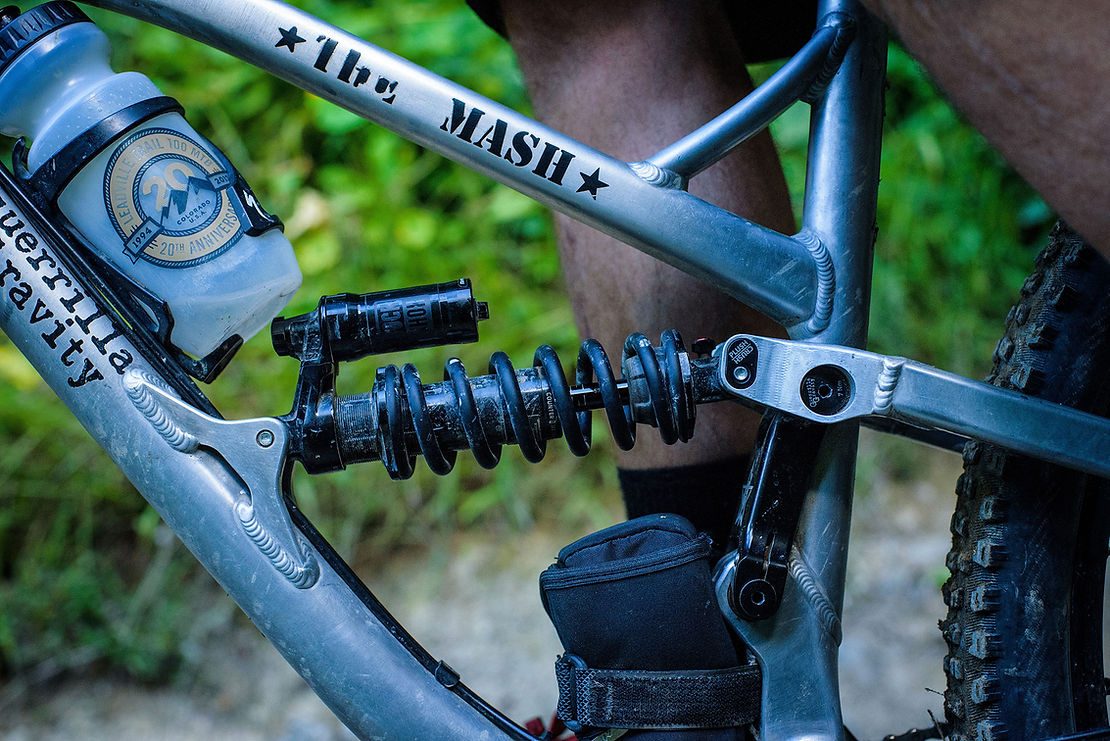
Nerding out on Springs
Of course, in the last decade air shocks have improved drastically. Claims of ‘coil-like performance’ abound with each new air shock launched to market. To an extent it’s true. Air shocks of today, with their larger, but tuneable positive chambers, larger negative chambers and slippery air seals, are more ‘coil like’ than ever, if not quite yet linear (more on that below). Also, air shocks rarely blow an air seal these days, whereas it used to be a regular occurrence, so their reliability is greatly improved too.
So, what does it mean to have a coil-like feel? What you might have heard before is that a coil shock has a linear spring curve. What does that mean? It means that at the start of the stroke, if it takes 400 pounds of force to compress the spring one inch (I’m using imperial because coil springs are measured in pounds), it will take another 400 pounds (800 pounds total) to compress the second inch and so on until the shock bottoms out at, for example, three inches of shock stroke and 1200 pounds of force. Air doesn’t compress in that linear way, it gets harder to compress further through the stroke, so if the first inch takes 400 pounds, depending on the size of the air chamber, it might be closer to 1600 pounds at the end of the three-inch stroke – even more if the shock has some volume reducers inside. This is what is meant by a ‘progressive’ shock rate. Of course, that’s not all…
Nerding out on Frames
Each frame’s suspension layout has its own linear or progressive behaviour too, independent of the shock choice. Ideally, you want the frame and the shock to be complementary. A linear frame-rate mated to a linear shock will make the whole package potentially too easy to bottom out and it won’t work very well for many riders, though it might for really lightweight riders. Having said that, a custom-tuned coil shock, like Push’s Elevensix, can take account of a linear frame-rate and produce a shock rate complementary to it. Conversely, a really progressive frame-rate mated to a progressive air shock (say one with the positive chamber stuffed full of volume reducers) will ramp up very rapidly so for many riders, they’ll never get anywhere near full travel, despite wallowing around in the mid-travel a lot.
So yeah, it’s complicated. But if you have a frame well suited to coil shocks (I’d list Santa Cruz, YT, many of the Intense range, Scott Bicycles, Giant Reigns, amongst many others) what do you stand to gain from a coil shock, and what might you lose?
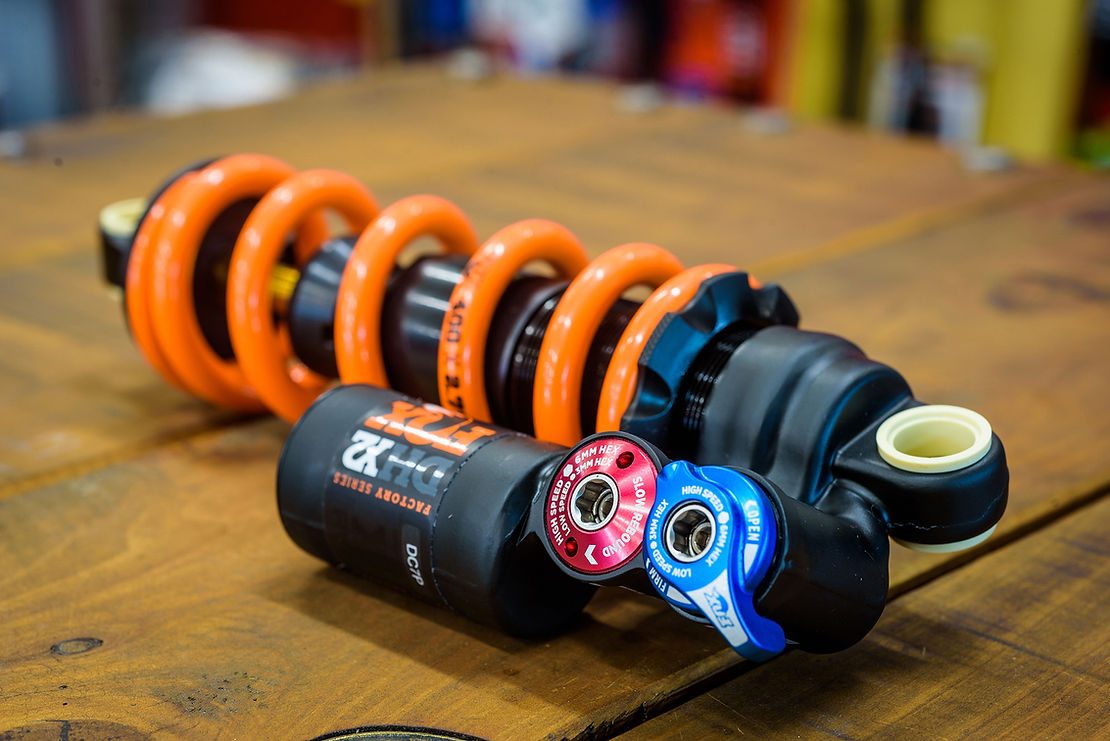
Possible Gains
Thanks to fewer seals, coil shocks have very little stiction and so are better at taking out the little chattery bumps, providing better traction and comfort. Some riders liken it to feeling like riding with a slightly flat tyre (but without the sidewall folding) because what should be chattery bumps just seem to disappear. Better traction helps your bike stay on line around rough corners and helps you slow down by letting the tyres grip rather than slide under braking. Comfort might not sound that important, but it can play a big part in how enjoyable a ride is, or how successful a race is. If you feel your hands and feet are rattled to pieces ¾ of the way through a ride or a race, your ride will start to suck and you’ll either be slower or risk crashing.
As well as more traction and comfort, a coil spring also falls into its middle-travel less readily (also called ‘mid-stroke support’) and can therefore provide better climbing, especially up steep climbs, and delivers better support when pushing the bike into corners. This is the part that I think a lot of riders misunderstand (I know I did until I rode a coil shock): if you’ve got the right weight coil, coil shocks provide more mid-stroke support, not less. It’s common for riders looking for more mid-stroke support to add volume reducers to their air shocks. But once you’ve lowered air pressure to still allow for full travel, what you’re likely to find is that mid-stroke support is lessened, not increased. If you don’t drop air pressure, you’ll simply not be able to access all the travel your bike has to offer.
A coil shock (with the right spring for your weight) will make their full travel more available, as opposed to air shocks which will ramp up harder at the end of the stroke (because, progressive), though this could also be a con, depending on how you ride and what frame the shock is fitted to.
Coil springs don’t get hot, and aren’t affected by changes in altitude. Warm air is harder to compress, and make your shock feel more harsh at the bottom of a run compared to the top.
Possible Losses
Coil springs are heavier. You’re likely to add in the order of 400 grams (the weight of the metal coil) switching to a coil shock, all else being equal. Is that weight something you can notice riding? No, it’s not, it’s a non-issue (our own testing with a power meter, published back in 2014, which mirrored what the physics would tell you, showed I needed an extra 0.25% (as in ¼ of a percent) increase in my power output to carry an additional 450 grams and go the same speed uphill).
Adjustability. If you put on or lose more than 5kg or so, you might need a different coil spring. They're not the most expensive thing to buy if you do need another.
Bottom out resistance. Depending on your frame, you could find that the linear nature of a coil spring means you bottom out the shock too much. Having said that, some of the most linear frame rates (like Specialized) have been run by very aggressive and fast riders on the EWS circuit with coil springs, so depending on the shock, you might find sophisticated high-speed compression damping can counteract this.
There is one other cost though, which is the hardest to describe and probably the most important for certain riders; that is ‘pop’, for want of a better description. It’s easier to get an air shock to bounce the bike off the ground when you want it to, which is down to its progressive nature(when the bike doesn’t bounce of the ground when we don’t want it to, we’d call this ‘traction’ or the bike being ‘planted’). This is not as easy to remedy as just running lighter rebound damping, it’s something else that’s oddly subtle yet also obviously felt. Ride a coil sprung shock, even on a bike you’re not overly familiar with, and you’ll probably feel it. Really active riders who like to jump off every trail feature (like ex-BMXers) are probably going to miss the pop the most.
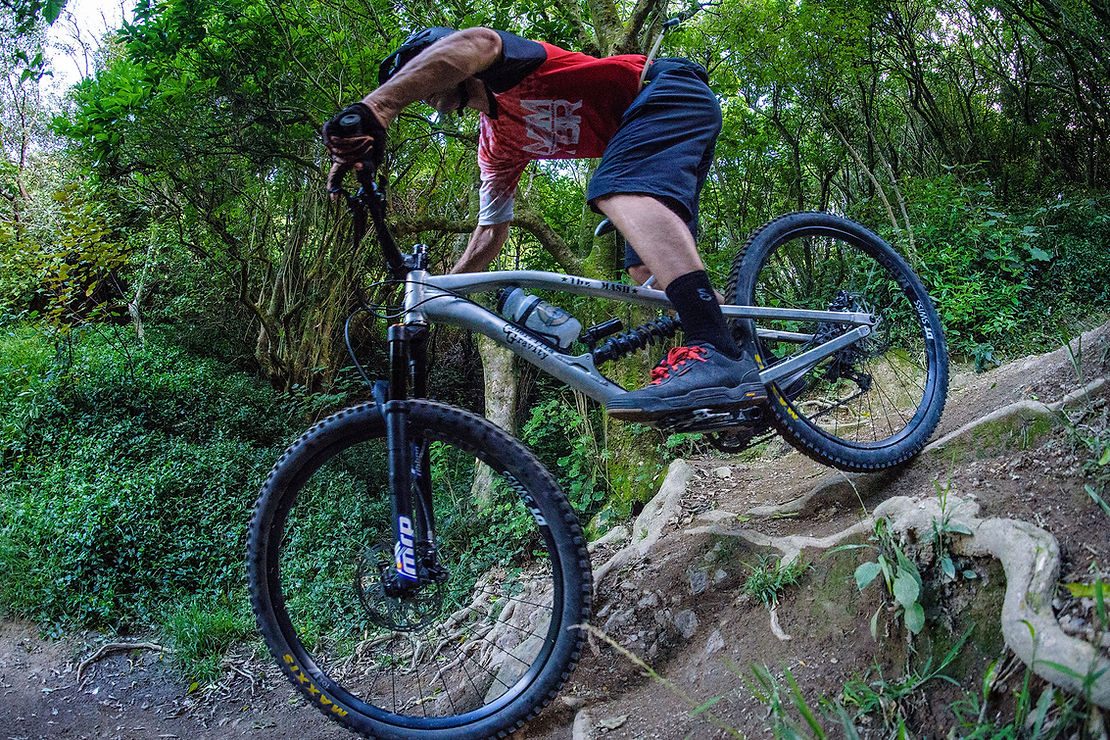
Wrap up
Is a coil shock worth considering? That depends. If you value traction and comfort, you prefer a firm middle supportive feel over a ‘forgiving’ or ‘soft centre’, you’d like to get to that last bit of travel a bit more easily, and you don’t mind losing a bit of pop, a coil spring is probably going to make your bike ride more like you want it to. That’s especially true if you I know you know you’re going to be riding rugged tracks or tracks where traction is needed. If, on the other hand, you regularly bottom out your air spring (assuming you’re not running the air-can with no reducers), or you love to bounce from one trail-double and root-kicker to the next, then a coil might detract from parts of your riding experience.
Words: Carl Patton
Images: Digby Shaw
Video: The Process X: It's So Sick
BREAKING NEWS! The Process X has been spotted out in the wild. We tap into field reporters Miranda Miller and Connor Fearon to get their impressions of the bike, what life was like before X, and where they see themselves in the future.
“Riding the Process X is so sick.”- Connor Fearon
“It’s friggin extreme.” - Miranda Miller
“Me and the Process X are gonna take on the world, one race at a time.” - Connor Fearon
“I don’t know how I lived without it, to be honest.” - Miranda Miller
News: The all-new Norco Shore
The mountains of Vancouver’s North Shore have ignited imaginations for decades - an enchanted realm formed by nature and hand sculpted with trails of triumph and confronting challenge.
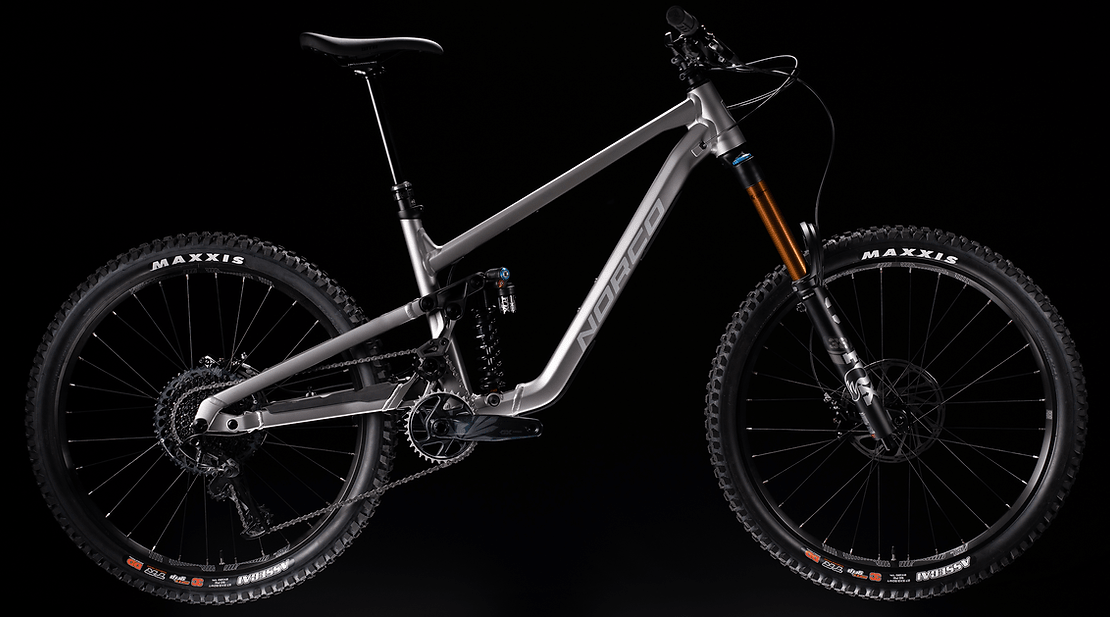
There is a life force at play here - intertwined with every rock, root and trail relic. It draws you in and alters your perception of the impossible, leaving an undeniable, indelible mark.
It’s where boundaries are broken and limits hyperextend. Where gravity meets technique and technology amplifies instinct to exploit every scrap of untapped potential.
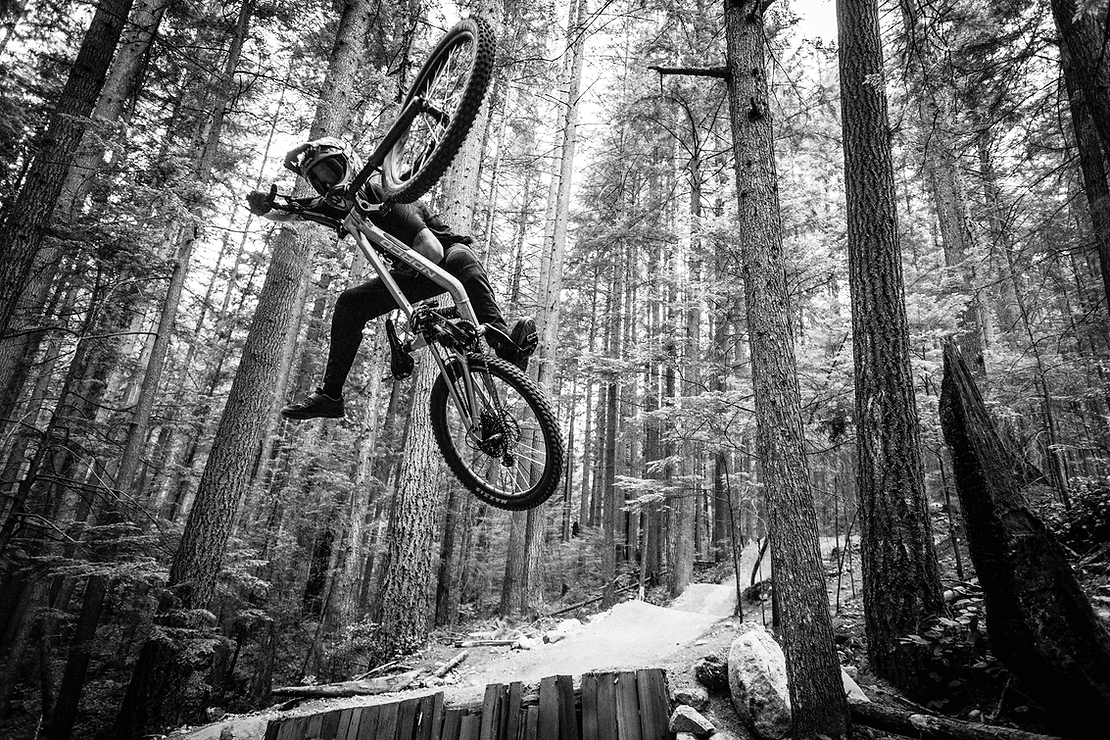
Twenty years have passed since we drafted the blueprint for the original Shore. The mountains of North Vancouver remain steadfast, demanding evermore from riders and their equipment. They are the ultimate inspiration and proving ground for the sublime big-mountain ride that’s driven by the mystical place that started it all, and demands the most from those who ride there.
The Shore uses Norco’s Ride Aligned™ Design System which matches each individual bike to the human who rides it, creating a customized Freeride platform that is both stable and balanced, allowing you to push harder. Using individual rider metrics, precise suspension kinematics, a proprietary app technology, you’ll align with your ride experience like never before.
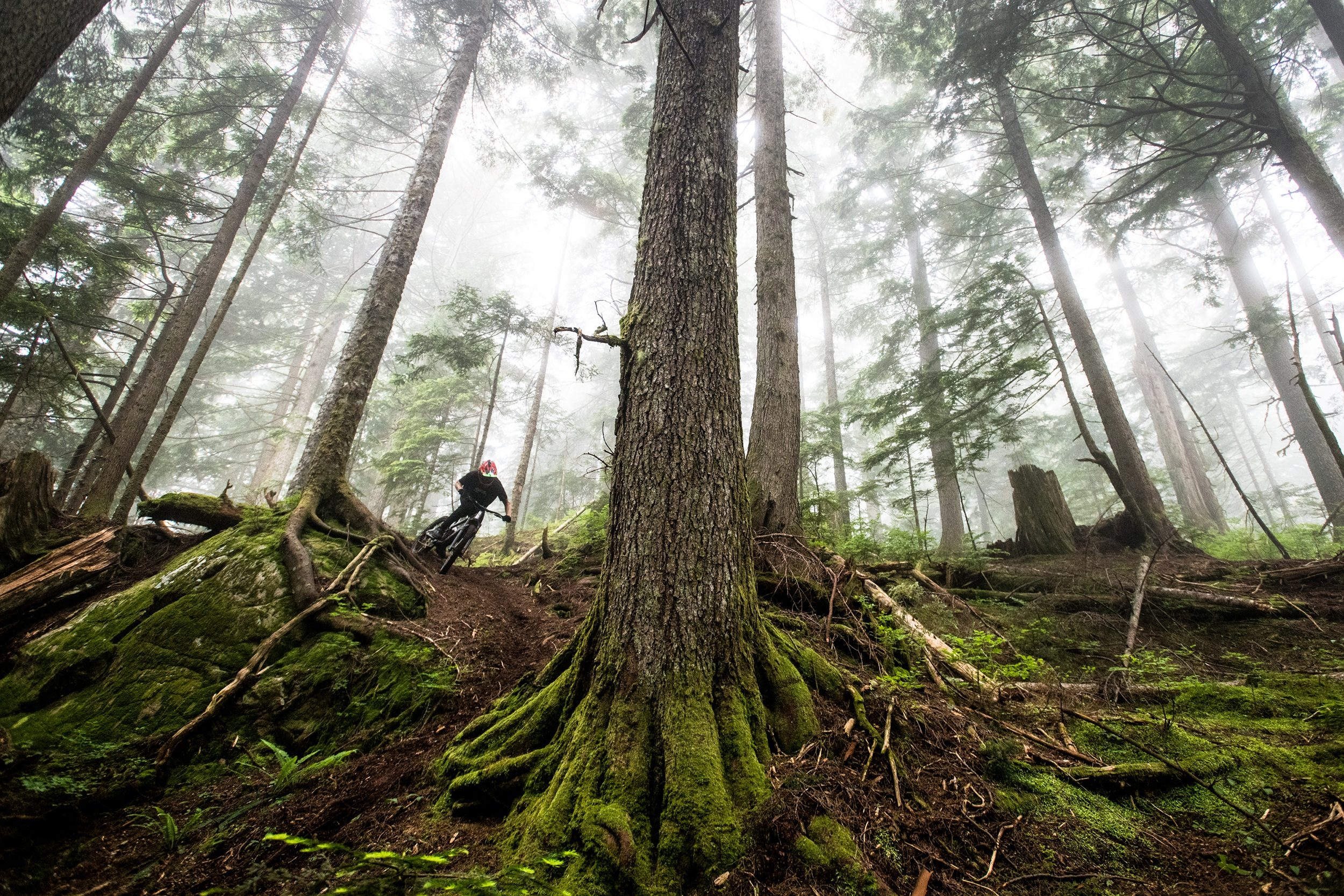
IDLER PULLEY
By integrating an idler pulley into an elevated pivot Horst Link suspension design, a rearward axle path can be achieved with minimal pedal kickback, and the precision coil-specific suspension kinematics ensure grip and support to boost jumps and shrug off deep landings on rough trails.
DYNAMIC PEDALING
Suspension design and rider compartment are designed to get the bike moving quickly on run-ins and rollers. Maximized pedal efficiency gets you to the top faster and conserves energy for the descent you’ve planned your whole ride around.
CHOOSE YOUR POISON
The Shore is available in two distinct configurations, depending on the type of riding you love. 180mm rear travel combined with a 180mm single crown fork and a wide-range 12-speed drivetrain for big, burly trail rides in the wild, and 190mm rear travel paired with a 200mm dual crown fork and a 7-speed drivetrain for big days at the bike park.
DURABLE DESIGN, EASY MAINTENANCE
Frame design, hardware and component decisions have been made specifically to keep the Shore on the trail and out of the shop – and when maintenance is necessary, it’s easy and quick.


